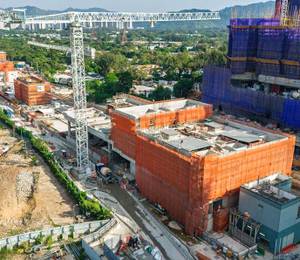There are currently eight Potain MCT 565 tower cranes split among two major projects in Singapore. Five of them are being used for the construction of the Sengkang West Bus Depot near Seletar, while the other three are operating at the site of the Hyundai Motor Group Innovation Centre in the Jurong Innovation District (JID). These 25-t rated cranes were rented to the projects’ contractors by local Potain fleet owner, Manta Equipment.
The five topless MCT 565 cranes at the Sengkang West Bus Depot were leased to Santarli Construction and Zheng Keng Engineering & Construction, the joint venture responsible for building this new transport hub. Erected between January and March of this year, the cranes are all operating at a working height of 60 m, with four units configured with 55 m jibs and one with a 50 m jib, for maximum jib-end capacities of 10 t and 12 t respectively.
The Sengkang West Bus Depot will be Singapore’s third multi-storey bus facility, accommodating approximately 600 of the country’s rapidly increasing bus fleet. It will include parking spaces, areas for refuelling and washing, repair and maintenance spaces, and administrative offices. A proposed dormitory for bus captains will maximise land use and reduce drivers’ travelling time to and from the depot. Completion is scheduled for 2024.
The Hyundai Motor Group Innovation Centre in Singapore (HMGICS) will be a new 44,000 sq m, seven-storey innovation lab, with a building footprint of 28,000 sq m. The three Potain MCT 565 cranes leading construction on the project were brought in between April and June of this year, where they were each erected to their 50 m working height within just two days of arrival.
While the MCT 565 offers a maximum potential jib length of 80 m, it also gives users a flexible choice of jib options, with contractors able to configure it in 5 m increments from 30 m up to the maximum 80 m. For the HMGICS job, main contractor Hyundai Engineering chose to fit two units with 65 m jibs and the other with a 60 m jib. In these set-ups, the cranes have end-of-jib capacities of 7.4 t and 8.7 t respectively, making them ideal for lifting precast concrete sections and other building materials.
Intended as a global base for Hyundai’s R&D experts, the HMGICS aims to revolutionise the future mobility value chain. It will also act as a test bed for a human-centred intelligent manufacturing platform with small-scale EV production on site. The roof will feature a landing port for Urban Air Mobility (UAM) vehicles, as well as solar panels to provide the site with clean, renewable energy. Construction is scheduled for completion by the end of 2022.
“Hyundai Engineering have long had trust and confidence in Potain cranes, so they were delighted with the proposal for three new Potain MCT 565 cranes for their project. They are only prepared to rely on the best possible equipment for such a spectacular project,” said Benjamin Goh, sales and marketing manager at Manta Equipment.
“Likewise, the main contractor on the Sengkang West Bus Depot project is a long-time Potain customer and appreciates the cranes’ reliability. This is an LTA (Land Transport Authority) project so there are strict protocols to follow, but because the cranes are new, the contractor avoided the need to get approval for their use.”
The Potain MCT 565 is built at Manitowoc’s facility in Zhangjiagang, China. Also available in 20 t and 32 t maximum capacities, the crane has several advantages beyond its recognised ease of transport and assembly.
With a compact design and innovative, space-saving features such as a folding cab on the slewing unit and a folding counter jib, each crane’s upper section can be shipped in just nine containers – four fewer than competing tower cranes of a similar size, said Manitowoc. There are also three counter jib options of 17 m, 21 m and 24 m to match the chosen jib length – a design feature that not only aids transportation and erection, but also optimises the crane’s overall footprint on tight job sites.











